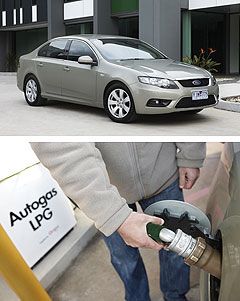Make / Model Search
News - General News - FuelsLPG conversion demand divesFuel for thought: The number of cars converted to LPG in Australia has dropped dramatically since 2008. 71 per cent fall in LPG car conversions has industry on the ropes24 May 2012 By IAN PORTER THE demand for the conversion of cars to liquefied petroleum gas (LPG) has all but collapsed, wreaking havoc in the conversion industry and prompting doubts about the fuel’s future in the transport industry. The dire state of the industry has prompted a call for a national marketing effort similar to those by apple growers, pork producers and other primary producers. An emergency seminar held in Melbourne on Wednesday night was told the number of cars converted to LPG had slumped 71 per cent from 2008 levels to just 27,976 in 2011. The collapse in demand for new LPG cars was even worse, with sales of new LPG cars – primarily Ford’s Falcon and Holden’s Commodore – plunging 77per cent to just 3072 cars in 2011. This, at least, can partly be explained by the absence from the market of the LPG Ford Falcon for much of 2011. “As you can see, we have been tracking since 2008 a very negative trend,” said LPG Association chief executive officer Mike Carmody at the seminar organised by the Victorian Automobile Chamber of Commerce (VACC). “If I was in any other industry, I would be talking about a collapse of the market. “And April was the worst month we have had since 2004.” Mr Carmody said he had spent a lot of time in recent months dispelling the notion that the fuel suppliers in the LPG industry were responsible for the surge in LPG pump prices. “The price spike was out of our hands,” he said. Mr Carmody said some people had blamed the fall in demand for conversions on the introduction of an excise on LGP from December 1 and on the retailers for the price spike. In fact, he said, the retailers had held prices down in November, December and January.  Left: Ford Falcon EcoLPI. Left: Ford Falcon EcoLPI.“What was really driving the spike was the Saudi contract price (for LPG) and the high demand for LPG in the northern hemisphere winter,” he said. Mr Carmody said the recent price spike was not the main culprit behind the industry’s sad situation at the moment, although it was a factor. He said the problem had been coming since 2008 when demand peaked at 93,803 conversions and 13,378 new LPG vehicles. By 2011, those figures had both fallen by more than 70 per cent. The slump in popularity meant that LPG now ran the risk of losing its place on the service station forecourt as it currently represented less than two per cent of service station revenue. The main reason it was still there was because the local refiners had to get rid of it somehow as it is a byproduct of petrol refining. Mr Carmody said it was hard to believe the fall in demand, given that LPG was still half the price of its main rival and had a well-established and wide distribution network. In addition, Australia had vast reserves of natural LPG and yet was importing almost half of its oil. As well, LPG could handle any engine technology introduced for petrol engines. “We have a fabulous product, but we are abysmal at telling the public about it,” Mr Carmody said. He said several negative factors were behind the decline in LPG conversions and new car sales and that the industry needed to come together and start talking with a single voice. The LPG experience for drivers was “terrible”, with a widespread perception that the conversion industry was dominated by “cowboys”. He said non-LPG drivers didn’t understand “the funny thing on the end of the hose”, while LPG pumps were always dirty and, on a long drive, motorists were often in the dark about LPG filling station locations. “Our surveys show that females, in particular, hate the LPG experience, at least until they become used to it,” he said. Mr Carmody said LPG Australia was running into some headwinds when it argued the case for LPG to politicians in Canberra. He said the government took the declining sales figures into account when it considered incentives and rebates designed to help the industry and wean motorists off petrol. In addition, a recent CSIRO study into transport fuels predicted that LPG would, based on current trends, simply fade away to nothing by 2025 or 2030. “It’s disturbing that this is the sort of information that ministers and bureaucrats are receiving,” Mr Carmody said. “Why would they be inclined to support LPG if that is the only information they have to go on?” At present, drivers who convert their cars to LPG receive a $1250 rebate from the federal government, while buyers of new LPG cars receive a $2000 rebate. LPG Australia did not have the funds to mount the sort of marketing campaign that was required, although it would be able to manage the campaign if its members wanted to join together to fund it and design it. He said after-market converters around Australia needed to come together and decide on a collective approach, which they would have to fund. “It will require a lot of collective effort, investment and commitment,” he said. “One large collective voice would be better than 600 individual businesses putting fliers in letterboxes.”  Read more |
Click to shareGeneral News articlesResearch General News Motor industry news |











Facebook Twitter Instagram